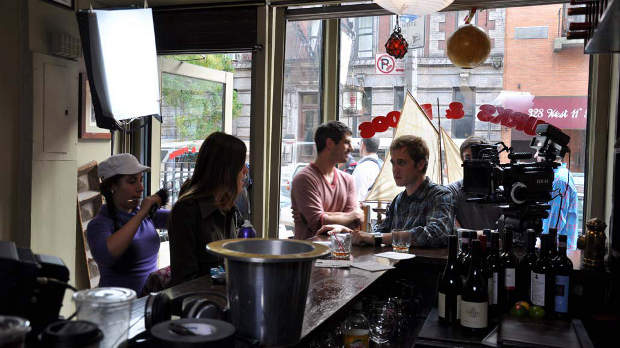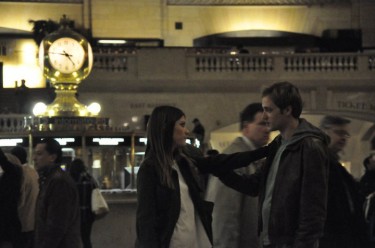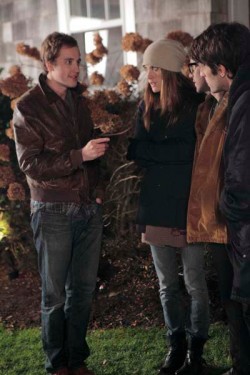 Back to selection
Back to selection
The Microbudget Conversation
We're Only Talking a Few Thousand Dollars by John Yost
The Microbudget Conversation : Ex Girlfriends

Earlier this month I had the opportunity to take a master class with Ted Hope and Christine Vachon. Now out of respect to them I will not reveal all that was discussed, but what I can tell you is that my perspective of things has been altered quite a bit. I first started this blog with the intention of showcasing microbudget work as the passionate filmmaking it is…and fuck the rules. (The whole series of manifestos is evidence of that.) We were making cinema fast and cheap, and we needed to completely re-write the rules; a message that can be exhilarating if not short-sided. Don’t get me wrong, the old way of making films will soon be gone forever, but there are just some tent poles that can’t be taken down. I don’t think the goal of this column has changed, but the amount I have learned from our readers and the wonderful folks I’ve met because of this column cannot go unabsorbed. This is a time for learning and growth in this industry, and my time waiting for the ground to stop shifting is over…it’s time to embrace the future with new ideas built over the skeleton of tradition. One of those beams is Authenticity. A wonderful byproduct of a collapsing industry, like the new elements formed from an exploding star, and if embraced could lead to a community of artists, audience members, and gatekeepers that could spell nothing but Renaissance.
This week our contributor is Alexander Poe, a recent Columbia graduate and filmmaker with plenty of experience under his belt. In this play by play of how he was able to “just go out and shoot” his first feature Ex-Girlfriends, Alex shows us that the “go get’m” attitude has to be mixed in with the foundations of good cinema; story, collaboration, and professionalism.
When I set out to write and direct my first micro-budget feature, Ex-Girlfriends, I tried to find out as much as I could about how other filmmakers had done it. To some degree each film requires a unique approach, but still I think it’s helpful to hear other filmmakers’ war stories and pick up what works for you.
A film shoot lives or dies based on the commitment of the cast and crew and on this one I had a great team: actress/executive producer Jennifer Carpenter, who decided to spend her break from Dexter running around New York with us shooting guerrilla style. My longtime friend and collaborator Joseph Varca who came on as co-Producer, production designer, and script supervisor. Cinematographer Gregory Kershaw who delivered great shots with limited resources. And most importantly, Producer/AD/editor Jennifer Gerber, who carried this film every step of the way through pre-production, production, and post all while somehow going to class at Columbia Film School for a few sleepless months.
Now as we reach the end of post-production I sat down to collect some thoughts on shooting micro-budget and to talk with Jennifer Carpenter and Jennifer Gerber about their perspective on the process via conference call.
2am ideas
It was the kind of decision you make in a bar at 2am… “I’m not going to wait around anymore for someone else to make my movie, I’m going to make it myself.” It seemed like a good idea at the time. I had tried just about every other way of getting to direct my first feature: writing spec features and trying to get them in the hands of “the right people,” working my way up as an assistant, going to film school, making shorts, and sending them to festivals.
Each step had made me a better, more experienced filmmaker, but actually getting someone with some means of production (a producer, a production company, a wealthy investor) to say: “Let’s make this movie” proved elusive. I had made enough shorts to add up to the running time of a feature, but I had always thought that making a feature is an entirely different process than making the scrappy no-budget shorts.
The short films I made had budgets of $50 – $5,000, were shot on some version of prosumer camera, over the course of a few days, with a cast and crew made up mostly of friends working for nothing. We filmed in people’s apartments, sneaking around their landlords, and stole shots on the street and the subway without permits. We often shot until we were kicked out of a place and then re-wrote the script to somehow have that make sense for the story.
Surely, I thought, features were not made this way… Features had real budgets, permits, trucks, production offices that were not my apartment, real locations where you weren’t under threat of eviction every day, catering with fresh fruit and friendly people handing you sandwiches all the time, trailers, the lights the DP actually requested, camera equipment that isn’t called “prosumer,” some kind of veteran producer who is friends with Christine Vachon who actually knows what a SAG contract looks like, AND investors who actually pay for the film.
Well… Somewhere people were making first features like that… But if your number doesn’t come up, you need to find another way to make your film.

Staying in the fight
Here’s the thing about trying to get money for a film: you can spend a lot of time chasing it, but at the end of the day if you haven’t actually made your movie you have nothing to show for it. I would rather have a $10,000 movie made today than a $1,000,000 movie that I have to wait two years to get into production. I’m a believer in the idea that work leads to more work and waiting leads to more waiting.
In our conference call, Carpenter hit the nail on the head: “Whether you want to be a writer, a director, or an actor, the secret is really just to stay in it. The ones who make it are the ones who keep fighting.”
All of which brings me back to the bar at 2AM… The place where lots of important life decisions seem to be made… Fortunately, the person I was ranting to over a glass of Jameson in 1020, a Morningside Heights dive bar that would later become a location in the film, was fellow Columbia film student and filmmaker Jennifer Gerber, who had experience as an AD/producer on commercials, industrials, and a bunch of short films. On top of that she is one of the hardest working people I know.
Jen started off by offering to help me put together a script breakdown and a budget that would take into account the small money I had to shoot the film.
Building the team
Ex-Girlfriends was a screenplay I had been working on for a while with the idea that it was something small enough that I could direct myself on a low budget. It’s a New York comedy/drama about three people who realize they’re caught up in a complicated relationship triangle and try to untangle it.
I had written to my resources and set the action in locations I felt reasonably sure I could find: bars, apartments, New York streets, parks, and a house in the Hamptons. Most of the roles were for actors in their 20s, a description that pretty much summed up my group of friends.
My cinematographer was another friend from Columbia, Gregory Kershaw. He lived a few blocks from me in Greenwich Village and was looking to get his first feature cinematography credit having shot a number of shorts. Greg really responded to the script. It was, after all, about angst-ridden twenty-somethings wandering around New York trying to sort out their lives, which is to say, it was about our day-to-day lives. While in pre-production, Greg and I would walk around the village, scouting locations and talking about the script, the visual language of the film and other films we liked that we wanted to use as reference points.
Jen, Greg and I had all studied with Columbia directing guru, Eric Mendelsohn (who won the Best Director award at Sundance last year for his film 3 Backyards), and so we had a common understanding of shot grammar and a mutual set of experiences from his weekly marathon class (running somewhere between eight to 12 hours). So lots of our creative conversations would go something like: “Remember that Mendelsohn class where we were watching The Exorcist shot for shot for 12 hours? This moment is like that shot where the detective asks for a cup of coffee and the camera jumps the line…”
Rounding out the team was Joseph Varca, a friend and longtime collaborator I had worked with for a long time doing plays and short films. He would come on as co-producer, adding another voice to our shot list conversations, our location scouts, and act as another eye on the monitor on set in addition to covering production design, additional casting and script supervision.
If you don’t have money to offer, you need to have people who are dedicated to your project and willing to go the distance with you no matter what. In a way, our team felt like a family. After a while we developed a short hand, working together all day, then sitting down for drinks to talk about the next day’s shot list. Without that kind of tight knit group who really believed in getting the film done no matter what, there is no way it would have happened.

Cast
Not having a lot of money, I knew that the one place I could really enhance the quality of the film was in casting great actors. While I hadn’t necessarily written with specific actors in mind, I knew a lot of actors in New York who I had worked with at the Williamstown Theater Festival in plays and in short films that I liked and trusted. In true Woody Allen fashion I decided that I was going to play the lead, something I had done in a number of short films and plays. To make sure everything would go smoothly I tried to work with actors that I had already worked with, or find friends of friends.
One week before shooting we had a casting crisis (this was before Jennifer Carpenter became involved).
I got a call from the lead actress: “Vampire Diaries just offered me a recurring role and I really have to take it…“ I turned and looked back at Jen, Joe, and Greg who are in the midst of tech-scouting frigid Hudson River Park for a scene we’re supposed to shoot with her in ten days. In the most professional tone I could manage I told her “I understand” and tried to figure out what the hell I was going to do while trying not to panic.
When it comes down to it, this is not an uncommon occurrence on films of this size (and films in general). Good actors are in demand and sometimes you lose them to other projects. It’s not the actor’s fault, they have careers to consider just like everyone else and sometimes conflicts come up. Everything is always a little bit luck of the draw and you have to just accept, move on and start making phone calls.
Kristen Connolly, the other lead in the film (and a friend from college who I had directed in my first short film) immediately put me in touch with her manager, Michael Lazo at Untitled Entertainment. Michael had been supportive of the project thus far and offered to help me cast the role.
“I’ll just send you over a list of our clients who are available” he said.
“Okay…” I said, still pretty sure the movie was over, or at least delayed for a long time.
An e-mail popped up on my phone. I looked at the list. It had a dozen names of high profile actresses all of whose work I deeply respected. From my perspective at that moment the subject of the email might as well have been: “Actresses who are out of your league.” I called Michael back.
“So… These actresses would actually be in my film?”
“You can offer them the role and they’ll consider it.”
“And they know it’s the SAG Ultra-Low Budget contract?” ($100 a day)
“Yes…” he said as if I was an insane person. “I like your script. So who do you want to make an offer to?”
So several days later I was having coffee at French Roast on 6th ave. with Jennifer Carpenter, trying not to sound like a star struck Dexter fan and also trying to figure out how the hell she was even considering being in my micro-budget film. What I quickly realized is that Jennifer is the type of dedicated actor who is hungry for good roles.
Here’s what Jennifer Carpenter said about signing on to the film: “I had been looking for a role where I could explore my comedic side and I just really liked the script. It’s always been my dream to be in a Woody Allen movie and there was something about the writing that had that same quality that I connected with right away. I remember you saying that this was a film that you wanted to keep small enough that you could make it yourself and I thought that was a really cool idea. Money can create so much unnecessary pressure [on bigger-budget films] and without that pressure there is the freedom to really focus on the script. I didn’t know any of you, except for that one coffee we had at French Roast, but right away I could tell that everyone working on the film was there because they were passionate about the project and I wanted to be part of it too.”
There’s one other thing you should know about Jennifer Carpenter: she’s a total bad ass. She had just run the NYC marathon, was still limping from the grueling race and excitedly telling me about an Antarctic sled race she was going to do with Johnny Lee Miller in a few months. Those actually turned out to be great qualifications to be involved with a micro-budget film: willing to endure long hours standing out in the cold? You’re in.

Crew
The other thing you can do to make your micro-budget film turn out well is to spend the time finding the right crew. No one is involved with a micro-budget film because of the money. They’re there because they believe in what you’re doing and want to be a part of it. You have to rely on people coming up through the ranks who are willing to work for a lower rate in order to get a feature credit and more experienced people who believe in your story enough to come on for cheap.
In our case, the dedication of the core team of Jen, Joe and Greg created an atmosphere of collaboration and openness on the set that made people we basically met only days before shooting feel like an integral part of the creative process. Our AC, Steve McBride, who had brought on his RED to the shoot went above and beyond to get us a superlative image. The sound recordist, Abe Gil, hustled like I’ve never seen a sound guy hustle on such a low-budget project. You have to find people who want to be involved with telling the story, and you have to let them bring their creative talents to the film. The real job of the director in relation to the crew (and in some sense the cast) is to give them the information they need and overall framework in order to give you all the pieces you need in order to construct your film in the edit room. If you tell people what you’re aiming for and then ask them how you can best get there.
All of the money in the world isn’t going to deliver a good film unless your core cast and crew is actively engaged with the story you’re trying to tell. In some sense a micro-budget creates a lot of difficulties because you’re restricted in the equipment you can afford, the number of crew members you can pay, and the number of days you can shoot. But the real advantage is that you start to come up with creative solutions to problems that a larger film would solve by throwing money at it. That’s where getting passionate cast and crew is really going to come into play: when your back is against the wall, you’re out of time, and you all need to pull together to get through the day. In Jen Gerber’s words: “Everyone was there because they wanted to make the best movie they could and they were donating so much more than their time and their skills to make it great.”
At the end of our conversation Jennifer Carpenter summed it up best: “The fact that everyone was in the trenches together really built a sense of camaraderie. The fight is always going to be hard so it’s always going to be about who is going to stay in it and create their own opportunities. If you won’t bet on yourself, who will?”
– Alexander Poe
Ex-Girlfriends is currently in the last stages of post-production and submission to film festivals. Clips, updates and info are at www.facebook.com/exgirlfriendsmovie and www.exgirlfriendsmovie.com
I think the most important thing to take away from all of this is, while it’s good to experiment, build your chops, and learn from your mistakes, NOTHING happens until you have a good story or script. Microbudget is still a wonderful way to do less waiting and more making, and each person is at a different level on their journey, but if you don’t learn from your mistakes, and continue to make films without strong foundations, then micro will never be a viable process. Authenticity, hard-work, and a good script are what you need to make a film…no matter what the budget.
We are still running our sound mix contest here, plenty of time to get your film in and win a chance to have it mixed by a pro!
This week also marks the end of a kickstarter campaign for fellow microbudget filmmaker and supporter Lucas McNeely. The difference between this campaign and his original campaign? This one is being put together by the folks he’s helped over the last few months. This is truly the microbudget spirit in action. Help MBC alumni Marty and his friends help Lucas help more of us!
We’d never turn down the chance to hear from you, especially microbudget fans and filmmakers. To become part of the conversation please send us your thoughts, responses, and questions.
